Assessment of Streamflow from EURO-CORDEX Regional Climate Simulations in Semi-Arid Catchments Using the SWAT Model
Abstract
:1. Introduction
2. Materials and Methods
2.1. Study Site
2.2. Input Data
2.3. SWAT Model
Calibration and Validation
2.4. Climate Scenarios
Statistical Bias Correction Method
3. Results and Discussion
3.1. Sensitivity Analysis
3.2. Hydrology
3.3. Evapotranspiration
3.4. Application of Bias Correction Methods for Hydrological Modeling
3.5. Changes in Climate Variables under RCP Scenarios
4. Conclusions
Author Contributions
Funding
Institutional Review Board Statement
Informed Consent Statement
Data Availability Statement
Acknowledgments
Conflicts of Interest
Appendix A
| RCMs | Upper Mula Basin | ||||||||
|---|---|---|---|---|---|---|---|---|---|
| Prec | Tmax | Tmin | |||||||
| NRMSE | r | SS | NRMSE | r | SS | NRMSE | r | SS | |
| CNRM-CCLM4-8-17 | 0.233 | 0.770 | 0.965 | 0.124 | 1.000 | 0.995 | 0.155 | 1.000 | 0.986 |
| CNRM-ALADIN53 | 0.828 | −0.220 | 0.769 | 0.098 | 1.000 | 0.997 | 0.482 | 1.000 | 0.819 |
| CNRM-RCA4 | 0.466 | 0.750 | 0.909 | 0.100 | 0.990 | 0.997 | 0.310 | 1.000 | 0.931 |
| ICHEC-CCLM4-8-17 | 0.310 | 0.820 | 0.923 | 0.119 | 1.000 | 0.996 | 0.170 | 1.000 | 0.982 |
| ICHEC-HIRHAM5 | 0.328 | 0.750 | 0.939 | 0.182 | 1.000 | 0.989 | 0.132 | 0.990 | 0.989 |
| ICHEC-RACMO22E | 0.560 | 0.540 | 0.873 | 0.158 | 1.000 | 0.992 | 0.356 | 1.000 | 0.906 |
| ICHEC-RCA4 | 0.293 | 0.660 | 0.949 | 0.113 | 1.000 | 0.996 | 0.357 | 1.000 | 0.904 |
| IPSL-WRF331F | 1.690 | −0.890 | 0.329 | 0.188 | 1.000 | 0.988 | 0.139 | 0.990 | 0.988 |
| IPSL-RCA4 | 0.569 | −0.130 | 0.674 | 0.066 | 1.000 | 0.999 | 0.267 | 1.000 | 0.952 |
| MOHC-CCLM4-8-17 | 0.284 | 0.860 | 0.938 | 0.119 | 1.000 | 0.996 | 0.132 | 1.000 | 0.990 |
| MOHC-RACMO22E | 0.431 | 0.690 | 0.918 | 0.086 | 1.000 | 0.998 | 0.269 | 1.000 | 0.953 |
| MOHC-RCA4 | 0.621 | 0.590 | 0.858 | 0.100 | 1.000 | 0.997 | 0.256 | 1.000 | 0.956 |
| MPI-CCLM4-8-17 | 0.284 | 0.620 | 0.944 | 0.083 | 1.000 | 0.998 | 0.098 | 1.000 | 0.995 |
| MPI-REMO2009 | 0.362 | 0.730 | 0.938 | 0.049 | 1.000 | 0.999 | 0.081 | 1.000 | 0.996 |
| MPI-RCA4 | 0.560 | 0.440 | 0.873 | 0.064 | 0.990 | 0.999 | 0.249 | 1.000 | 0.958 |
| NCC-HIRHAM5 | 0.397 | 0.530 | 0.894 | 0.121 | 0.990 | 0.995 | 0.070 | 0.990 | 0.997 |
| RCMs | Algeciras Basin | |||||||||
|---|---|---|---|---|---|---|---|---|---|---|
| Prec | Tmax | Tmin | ||||||||
| NRMSE | r | SS | NRMSE | r | SS | NRMSE | r | SS | ||
| CNRM-CCLM4-8-17 | 0.204 | 0.810 | 0.960 | 0.164 | 0.990 | 0.991 | 0.098 | 0.990 | 0.994 | |
| CNRM-ALADIN53 | 0.912 | −0.200 | 0.690 | 0.115 | 1.000 | 0.996 | 0.255 | 1.000 | 0.940 | |
| CNRM-RCA4 | 0.292 | 0.700 | 0.936 | 0.146 | 0.980 | 0.993 | 0.079 | 0.990 | 0.995 | |
| ICHEC-CCLM4-8-17 | 0.350 | 0.540 | 0.872 | 0.166 | 0.990 | 0.990 | 0.067 | 0.990 | 0.997 | |
| ICHEC-HIRHAM5 | 0.482 | 0.760 | 0.876 | 0.206 | 0.990 | 0.985 | 0.128 | 0.990 | 0.989 | |
| ICHEC-RACMO22E | 0.737 | 0.480 | 0.763 | 0.225 | 0.990 | 0.981 | 0.156 | 0.990 | 0.979 | |
| ICHEC-RCA4 | 0.365 | 0.520 | 0.885 | 0.170 | 0.990 | 0.990 | 0.128 | 1.000 | 0.986 | |
| IPSL-WRF331F | 0.987 | −0.790 | 0.305 | 0.202 | 0.990 | 0.985 | 0.138 | 0.990 | 0.988 | |
| IPSL-RCA4 | 0.584 | 0.450 | 0.472 | 0.047 | 0.990 | 0.999 | 0.053 | 1.000 | 0.998 | |
| MOHC-CCLM4-8-17 | 0.190 | 0.880 | 0.964 | 0.109 | 1.000 | 0.996 | 0.146 | 0.990 | 0.987 | |
| MOHC-RACMO22E | 0.650 | 0.480 | 0.814 | 0.121 | 1.000 | 0.995 | 0.087 | 1.000 | 0.994 | |
| MOHC-RCA4 | 0.270 | 0.760 | 0.953 | 0.086 | 0.990 | 0.998 | 0.039 | 1.000 | 0.999 | |
| MPI-CCLM4-8-17 | 0.328 | 0.480 | 0.917 | 0.113 | 1.000 | 0.996 | 0.134 | 1.000 | 0.989 | |
| MPI-REMO2009 | 0.431 | 0.520 | 0.879 | 0.020 | 1.000 | 1.000 | 0.145 | 1.000 | 0.987 | |
| MPI-RCA4 | 0.365 | 0.620 | 0.911 | 0.102 | 1.000 | 0.997 | 0.030 | 1.000 | 0.999 | |
| NCC-HIRHAM5 | 0.307 | 0.630 | 0.923 | 0.151 | 0.990 | 0.992 | 0.217 | 0.980 | 0.972 | |
| RCMs | Upper Mula Basin | Algeciras Basin | ||||||
|---|---|---|---|---|---|---|---|---|
| Prec Rank | Tmax Rank | Tmin Rank | RM | Prec Rank | Tmax Rank | Tmin Rank | RM | |
| CNRM-CCLM4-8-17 | 2 | 11 | 7 | 5 | 1 | 13 | 7 | 4 |
| CNRM-ALADIN53 | 14 | 7 | 16 | 14 | 14 | 6 | 16 | 14 |
| CNRM-RCA4 | 4 | 9 | 5 | 4 | 9 | 8 | 13 | 12 |
| ICHEC-CCLM4-8-17 | 11 | 12 | 4 | 10 | 7 | 11 | 8 | 9 |
| ICHEC-HIRHAM5 | 10 | 15 | 8 | 12 | 4 | 15 | 5 | 6 |
| ICHEC-RACMO22E | 13 | 16 | 14 | 16 | 11 | 14 | 14 | 16 |
| ICHEC-RCA4 | 8 | 13 | 13 | 13 | 2 | 9 | 15 | 10 |
| IPSL-WRF331F | 16 | 14 | 10 | 15 | 16 | 16 | 6 | 15 |
| IPSL-RCA4 | 15 | 2 | 3 | 6 | 15 | 2 | 12 | 11 |
| MOHC-CCLM4-8-17 | 1 | 5 | 11 | 3 | 6 | 10 | 4 | 3 |
| MOHC-RACMO22E | 12 | 8 | 6 | 9 | 8 | 5 | 11 | 7 |
| MOHC-RCA4 | 3 | 3 | 2 | 1 | 13 | 7 | 10 | 13 |
| MPI-CCLM4-8-17 | 6 | 6 | 9 | 7 | 3 | 4 | 3 | 2 |
| MPI-REMO2009 | 9 | 1 | 12 | 8 | 5 | 1 | 2 | 1 |
| MPI-RCA4 | 7 | 4 | 1 | 2 | 12 | 3 | 9 | 8 |
| NCC-HIRHAM5 | 5 | 10 | 15 | 11 | 10 | 12 | 1 | 5 |
References
- IPCC. Scientific Assessment of Climate Change: World Meteorological Organisation/United Nations Environmental Programme; Cambridge University Press: Cambridge, UK, 1990. [Google Scholar]
- Bates, B.C.; Kundzewicz, Z.W.; Wu, S.; Palutikof, J.P. El Cambio Climático y el Agua; Documento Técnico del Grupo Intergubernamental de Expertos sobre el Cambio Climático; Secretaría del IPCC: Ginebra, Switzerland, 2008. [Google Scholar]
- Stocker, T.F.; Qin, D.; Plattner, G.K.; Tignor, M.; Allen, S.K.; Boschung, J.; Nauels, A.; Xia, Y.; Bex, V.; Midgley, P.M. Climate Change 2013: The Physical Science Basis; Working J Group I Contribution to the Fifth Assessment Report of the Intergovernmental Panel on Climate Change, Summary for Policymakers; Cambridge University Press: Cambridge, UK, 2013. [Google Scholar] [CrossRef]
- Jacob, D.; Petersen, J.; Eggert, B.; Alias, A.; Christensen, O.B.; Bouwer, L.M.; Braun, A.; Colette, A.; Deque, M.; Georgievski, G.B.; et al. EURO-CORDEX: New high-resolution climate change projections for European impact research. Reg. Environ. Chang. 2014, 14, 563–578. [Google Scholar] [CrossRef]
- Schnabel, S.; Lozano-Parra, J.; Gómez-Gutiérrez, A.; Alfonso-Torreño, A. Hydrological dynamics in a small catchment with silvopastoral land use in SW Spain. Cuad. Investig. Geogr. 2018, 44, 557–580. [Google Scholar] [CrossRef] [Green Version]
- El Moçayd, N.; Kang, S.; Eltahir, E.A.B. Climate Change impacts the Water Highway project in Morocco. Hydrol. Earth Syst. Sci. Discuss. 2019, 24, 1467–1483. [Google Scholar] [CrossRef] [Green Version]
- Khalilian, S.; Shahvari, N.A. SWAT Evaluation of the Effects of Climate Change on Renewable Water Resources in Salt Lake Sub-Basin, Iran. AgriEngineering 2019, 1, 44–57. [Google Scholar] [CrossRef]
- Estrela, T.; Pérez-Martin, M.A.; Vargas, E. Impacts of climate change on water resources in Spain. Hydrol. Sci. J. 2012, 57, 1154–1167. [Google Scholar] [CrossRef]
- Agencia Estatal de Meteorología (AEMET). Resumen Anual Climatológico 2017; Resumen anual climatológico-España; AEMET: Madrid, Spain, 2017. [Google Scholar]
- Senent, M.; García-Aróstegui, J.L. Sobreexplotación de Acuíferos en la Cuenca del Segura: Evaluación y Perspectivas; Fundación Instituto Euromediterráneo del Agua: Murcia, Spain, 2014. [Google Scholar]
- Morote, Á.-F.; Olcina, J.; Rico, A.-M. Challenges and Proposals for Socio-Ecological Sustainability of the Tagus–Segura Aqueduct (Spain) under Climate Change. Sustainability 2017, 9, 2058. [Google Scholar] [CrossRef] [Green Version]
- Senent-Aparicio, J.; Pérez-Sánchez, J.; Carrillo-García, J.; Soto, J. Using SWAT and Fuzzy TOPSIS to Assess the Impact of Climate Change in the Headwaters of the Segura River Basin (SE Spain). Water 2017, 9, 149. [Google Scholar] [CrossRef] [Green Version]
- Jodar-Abellan, A.; Ruiz, M.; Melgarejo, J. Evaluación del impacto del cambio climático sobre una cuenca hidrológica en régimen natural (SE, España) usando un modelo SWAT. Rev. Mex. Cienc. Geol. 2018, 35, 240–253. [Google Scholar] [CrossRef]
- Álvarez-Rogel, J.; Barberá, G.G.; Maxwell, B.; Guerrero-Brotons, M.; Díaz-García, C.; Martínez-Sánchez, J.J.; Sallent, A.; Martínez-Ródenas, J.; González-Alcaraz, M.N.; Jiménez-Cárceles, F.J.; et al. The case of Mar Menor eutrophication: State of the art and description of tested Nature-Based Solutions. Ecol. Eng. 2020, 158, 10608. [Google Scholar] [CrossRef]
- Gassman, P.W.; Sadeghi, A.M.; Srinivasan, R. Applications of the SWAT model special section: Overview and insights. J. Environ. Qual. 2014, 43, 1–8. [Google Scholar] [CrossRef] [PubMed]
- Zahabiyoun, B.; Goodarzi, M.R.; Bavani, A.R.M.; Azamathulla, H.M. Assessment of Climate Change Impact on the Gharesou River Basin Using SWAT Hydrological Model. Clean Soil Air Water 2013, 41, 601–609. [Google Scholar] [CrossRef]
- Shimola, K.; Muthiah, K. Sensitivity of SWAT simulated reservoir inflow to climate change in a semi arid basin. Mausam 2015, 66, 181–186. [Google Scholar]
- Neitsch, S.L.; Arnold, J.G.; Kiniry, J.R.; Williams, J.R. Soil and Water Assessment Tool Theoretical Documentation-Version 2009; Soil and water research laboratory, US Department of Agriculture—Agricultural Research Service: Temple, TX, USA, 2009. [Google Scholar]
- Arnold, J.G.; Kiniry, J.R.; Srinivasan, R.; Williams, J.R.; Haney, E.B.; Neitsch, S.L. Soil and Water Assessment Tool Input/Output File Documentation; Version 2009; Texas Water Resources Institute: Temple, TX, USA, 2011. [Google Scholar]
- Hargreaves, G.L.; Hargreaves, G.H.; Riley, J.P. Agricultural benefits for Senegal River watershed. J. Irrig. Drain. Eng. 1985, 111, 111–124. [Google Scholar] [CrossRef]
- Priestley, C.H.B.; Taylor, R.J. On the assessment of surface heat flux and evaporation using large-scale parameters. Mon. Weather Rev. 1972, 100, 81–92. [Google Scholar] [CrossRef]
- Monteith, J.L. Evaporation and Environment. Symp. Soc. Exp. Biol. 1965, 19, 205–234. [Google Scholar]
- Licciardello, F.; Rossi, C.; Srinivasan, R.; Zimbone, S.M.; Barbagallo, S. Hydrologic evaluation of a Mediterranean watershed using the SWAT model with multiple PET estimation methods. Trans. ASABE 2011, 54, 1615–1625. [Google Scholar] [CrossRef]
- Alemayehu, T.; Griensven, A.; Bauwens, W. Evaluating CFSR and WATCH data as input to SWAT for the estimation of the potential evapotranspiration in a data-scarce eastern-African catchment. J. Hydrol. Eng. 2015, 21, 1–16. [Google Scholar] [CrossRef]
- Samadi, S.Z. Assessing the sensitivity of SWAT physical parameters to potential evapotranspiration estimation methods over a coastal plain watershed in the southeastern United States. Hydrol. Res. 2017, 48, 395–415. [Google Scholar] [CrossRef]
- Tamm, O.; Maasikamäe, S.; Padari, A.; Tamm, T. Modelling the effects of land use and climate change on the water resources in the eastern Baltic Sea region using the SWAT model. Catena 2018, 167, 78–89. [Google Scholar] [CrossRef]
- Martínez-Salvador, A.; Conesa-García, C. Suitability of the SWAT Model for Simulating Water Discharge and Sediment Load in a Karst Watershed of the Semiarid Mediterranean Basin. Water Resour. Manag. 2020, 34, 785–802. [Google Scholar] [CrossRef]
- Moriasi, D.N. Model evaluation guidelines for systematic quantification of accuracy in watershed simulations. Trans. ASABE 2007, 50, 885–900. [Google Scholar] [CrossRef]
- Rocha, J. Impacts of climate change on reservoir water availability, quality and irrigation needs in a water scarce Mediterranean region (southern Portugal). Sci. Total Environ. 2020, 736, 139477. [Google Scholar] [CrossRef] [PubMed]
- Nerantzaki, S.D.; Hristopulos, D.T.; Nikolaidis, N.P. Estimation of the uncertainty of hydrologic predictions in a karstic Mediterranean watershed. Sci. Total Environ. 2020, 717, 137131. [Google Scholar] [CrossRef] [PubMed]
- Teutschbein, C.; Seibert, J. Bias correction of regional climate model simulations for hydrological climate-change impact studies: Review and evaluation of different methods. J. Hydrol. 2012, 456, 12–29. [Google Scholar] [CrossRef]
- Teutschbein, C.; Seibert, J. Is bias correction of regional climate model (RCM) simulations possible for non-stationary conditions. Hydrol. Earth Syst. Sci. 2013, 17, 5061–5077. [Google Scholar] [CrossRef] [Green Version]
- Ehret, U.; Zehe, E.; Wulfmeyer, V.; Warrach-Sagi, K.; Liebert, J. HESS Opinions “Should we apply bias correction to global and regional climate model data?” Hydrol. Earth. Syst. Sci. 2012, 16, 3391–3404. [Google Scholar] [CrossRef] [Green Version]
- Mukundan, R.; Radcliffe, D.E.; Risse, L.M. Spatial resolution of soil data and channel erosion effects on SWAT model predictions of flow and sediment. J. Soil Water Conserv. 2010, 65, 92–104. [Google Scholar] [CrossRef] [Green Version]
- Sehgal, V.; Sridhar, V.; Juran, L.; Ogejo, J. Integrating Climate Forecasts with the Soil and Water Assessment Tool (SWAT) for High-Resolution Hydrologic Simulations and Forecasts in the Southeastern US. Sustainability 2018, 10, 3079. [Google Scholar] [CrossRef] [Green Version]
- Luan, X.B. Impact of land use change on hydrologic processes in a large plain irrigation district. Water. Resour. Manag. 2018, 32, 3203–3217. [Google Scholar] [CrossRef]
- Asl-Rousta, B.; Mousavi, S.J.; Ehtiat, M. SWAT-based hydrological Modelling using model selection criteria. Water. Resour. Manag. 2018, 32, 2181–2197. [Google Scholar] [CrossRef]
- Me, W.; Abell, J.M.; Hamilton, D.P. Effects of hydrologic conditions on SWAT model performance and parameter sensitivity for a small, mixed land use catchment in New Zealand. Hydrol. Earth Syst. Sci. 2015, 19, 4127–4147. [Google Scholar] [CrossRef] [Green Version]
- Hayal, D.; Brook, L. SWAT based hydrological assessment and characterization of Lake Ziway sub-watersheds, Ethiopia. J. Hydrol. Reg. Stud. 2017, 13, 122–137. [Google Scholar] [CrossRef]
- Lane, L.J. Transmission Losses. In Soil Conservation Service; National Engineering Handbook; U.S. Government Printing Office: Washington, DC, USA, 1983. [Google Scholar]
- Ficklin, D.L.; Stewart, I.T.; Maurer, E.P. Climate Change Impacts on Streamflow and Subbasin-Scale Hydrology in the Upper Colorado River Basin. PloS ONE 2013, 8, e71297. [Google Scholar] [CrossRef] [PubMed]
- Nikolaidis, N.P.; Bouraoui, F.; Bidoglio, G. Hydrologic and geochemical modeling of a karstic Mediterranean watershed. J. Hydrol. 2013, 477, 129–138. [Google Scholar] [CrossRef]
- Yesuf, H.M.; Assen, M.; Alamirew, T.; Melesse, A.M. Modeling of sediment yield in Maybar gauged watershed using SWAT, Northeast Ethiopia. Catena 2015, 127, 191–205. [Google Scholar] [CrossRef]
- Zhang, A.J.; Zheng, C.M.; Wang, S.; Yao, Y.Y. Analysis of streamflow variations in the Heihe River Basin, northwest China: Trends, abrupt changes, driving factors and ecological influences. J. Hydrol. Reg. Stud. 2015, 3, 106–124. [Google Scholar] [CrossRef] [Green Version]
- Biru, Z.; Kumar, D. Calibration and validation of SWAT model using stream flow and sediment load for Mojo watershed, Ethiopia. Sustain. Water Resour. Manag. 2017, 4, 937–949. [Google Scholar] [CrossRef]
- Santos, C.A.S.; Almeida, C.; Ramos, T.B.; Rocha, F.A.; Oliveira, R.; Neves, R. Using a Hierarchical Approach to Calibrate SWAT and Predict the Semi-Arid Hydrologic Regime of Northeastern Brazil. Water 2018, 10, 1137. [Google Scholar] [CrossRef]
- Rao, L.Y.; Sun, G.; Ford, C.R.; Vose, J.M. Modeling Potential Evapotranspiration of Two Forested Watersheds in the Southern Appalachians. Trans. ASABE 2011, 54, 2067–2078. [Google Scholar] [CrossRef]
- Kum, D.; Lim, K.J.; Jang, C.H.; Ryu, J.; Yang, J.E.; Kim, S.J.; Kong, D.S.; Jung, Y. Projecting future climate change scenarios using three bias-correction methods. Adv. Meteorol. 2014, 704151. [Google Scholar] [CrossRef]
- Luo, M.; Liu, T.; Meng, F.; Duan, Y.; Frankl, A.; Bao, A.; De Maeyer, P. Comparing Bias Correction Methods Used in Downscaling Precipitation and Temperature from Regional Climate Models: A Case Study from the Kaidu River Basin in Western China. Water 2018, 10, 1046. [Google Scholar] [CrossRef] [Green Version]
- Piani, C.; Haerter, J.; Coppola, E. Statistical bias correction for daily precipitation in regional climate models over Europe. Theor. Appl. Climatol. 2010, 99, 187–192. [Google Scholar] [CrossRef] [Green Version]
- Nunes, J.P.; Jacinto, R.; Keizer, J.J. Combined impacts of climate and socio economic scenarios on irrigation water availability for a dry Mediterranean reservoir. Sci. Total Environ. 2017, 584–585, 219–233. [Google Scholar] [CrossRef] [PubMed]
- CHS. Plan Hidrológico de la Demarcación del Segura 2015/21; Confederación Hidrográfica del Segura: Murcia, Spain, 2015. [Google Scholar]
- CEDEX. Evaluación del Impacto del Cambio Climático en los Recursos Hídricos y Sequías en España; Centro de Estudios Hidrográficos: Madrid, Spain, 2017. [Google Scholar]
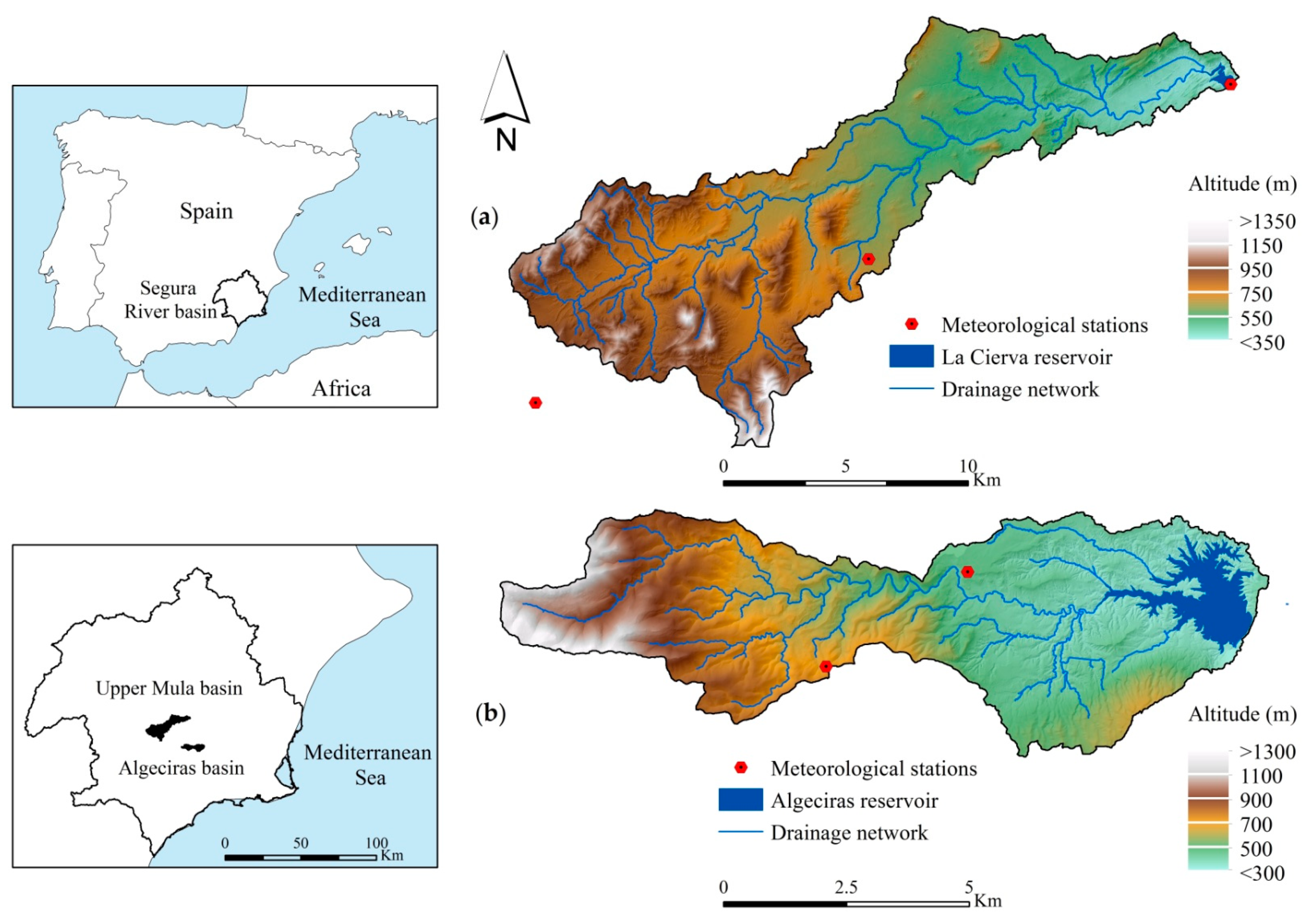
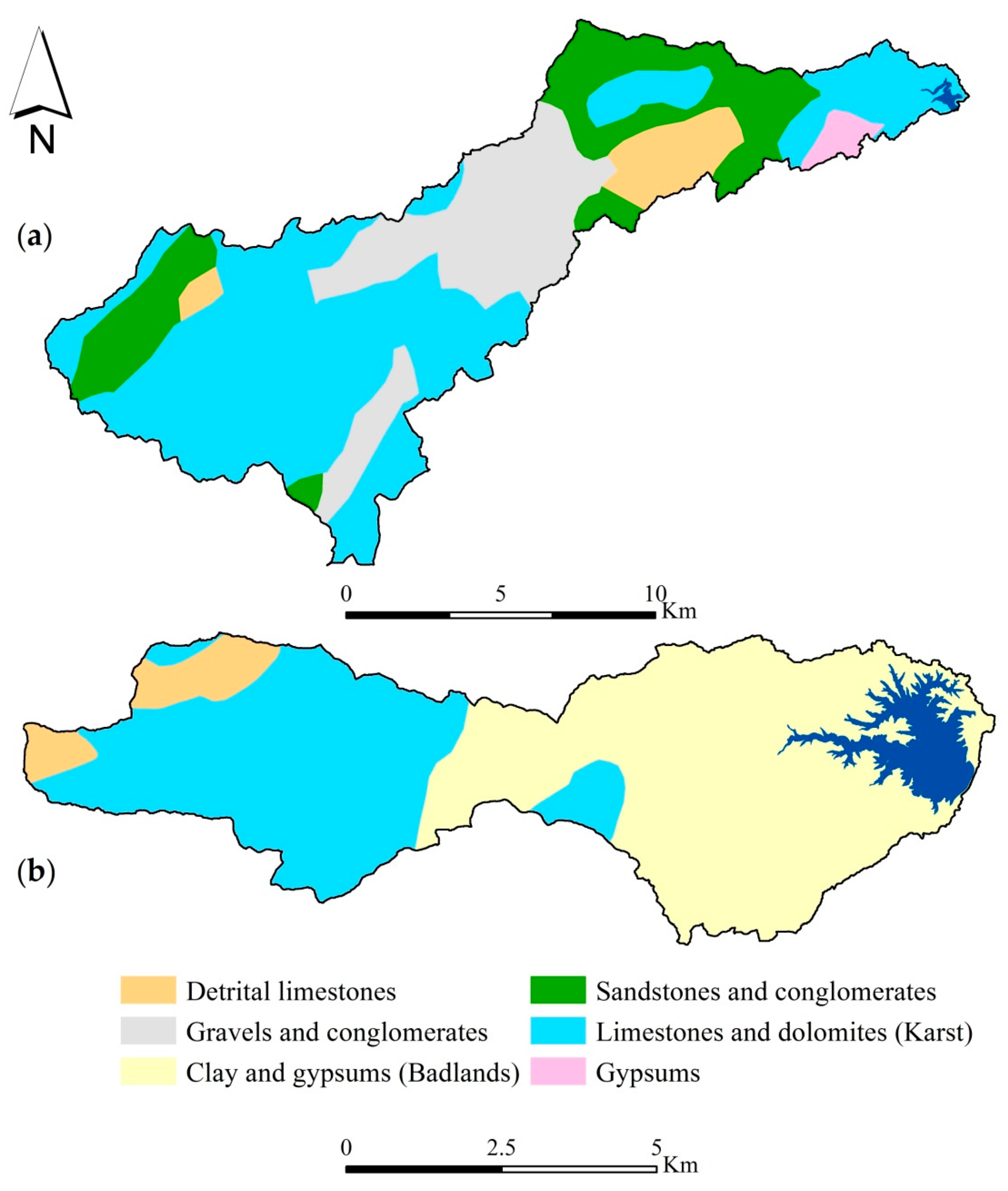
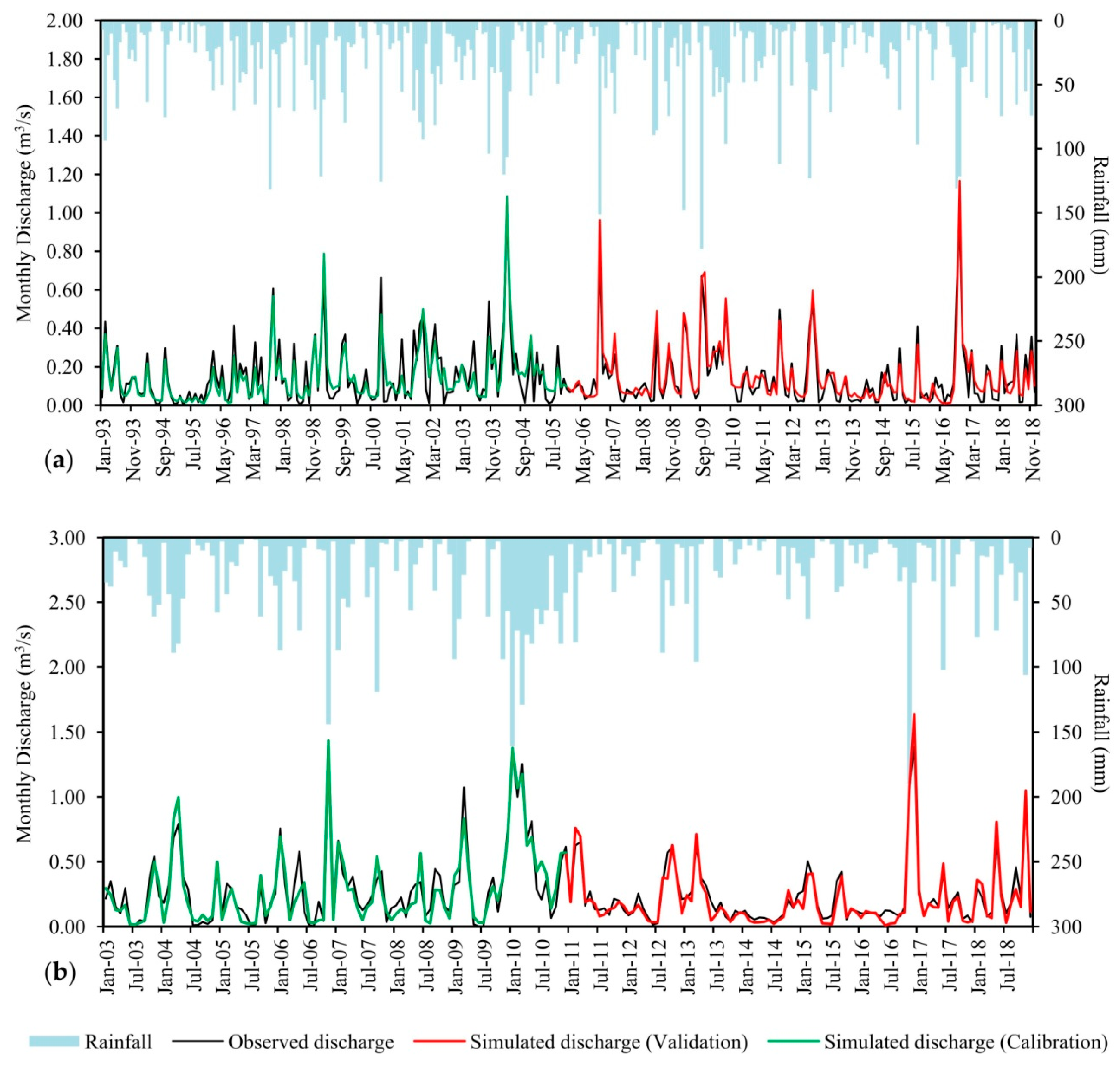
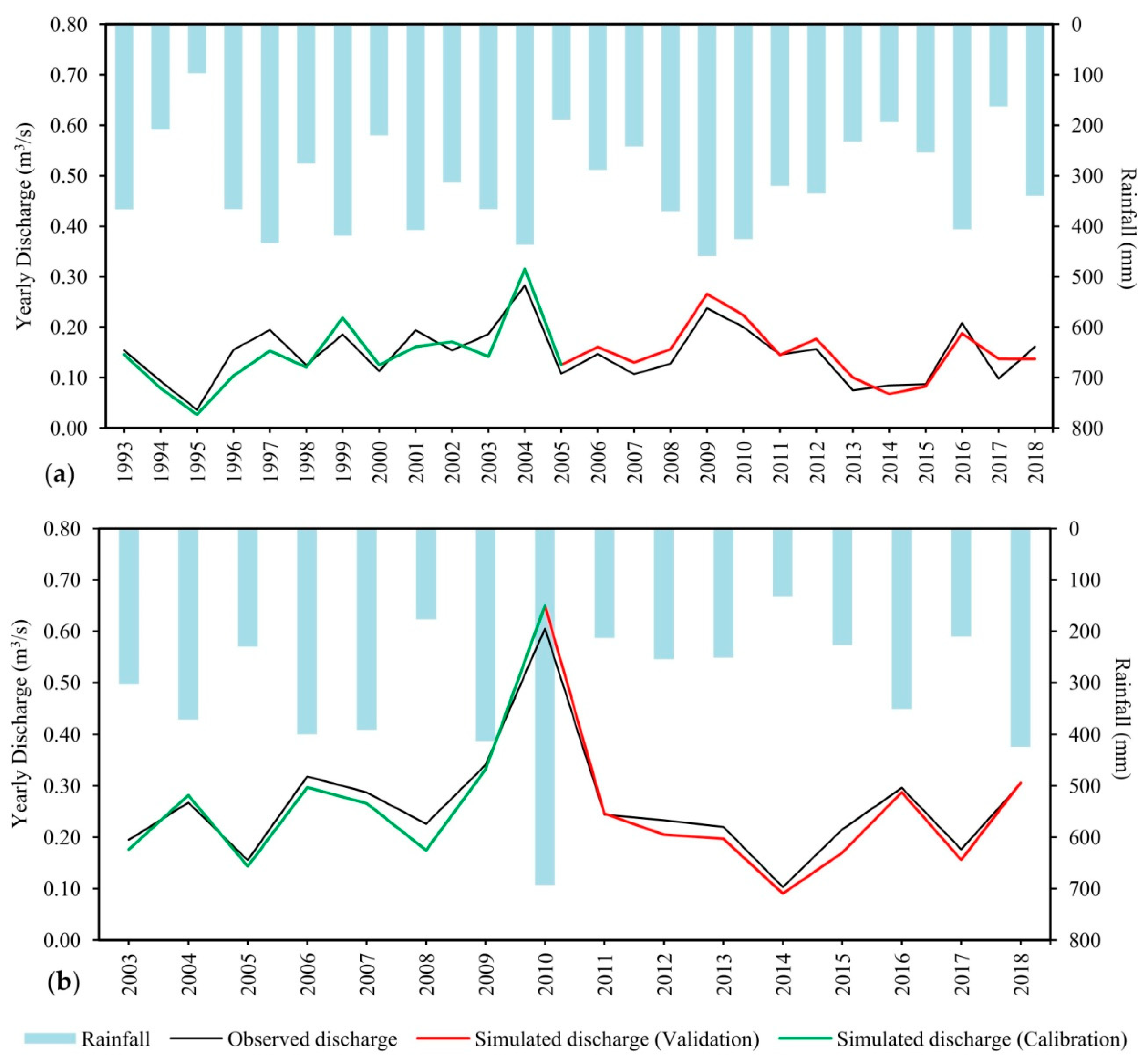
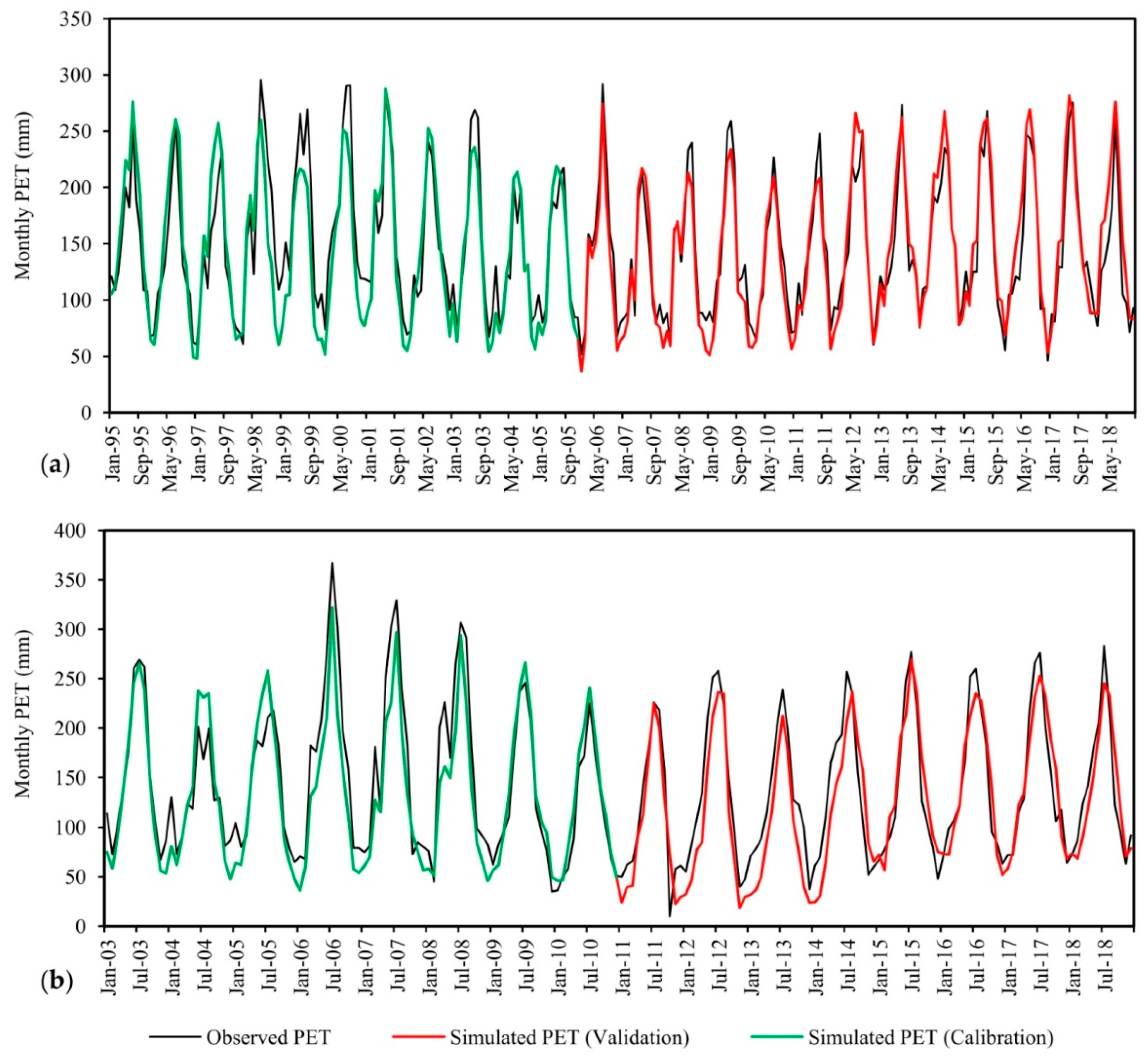
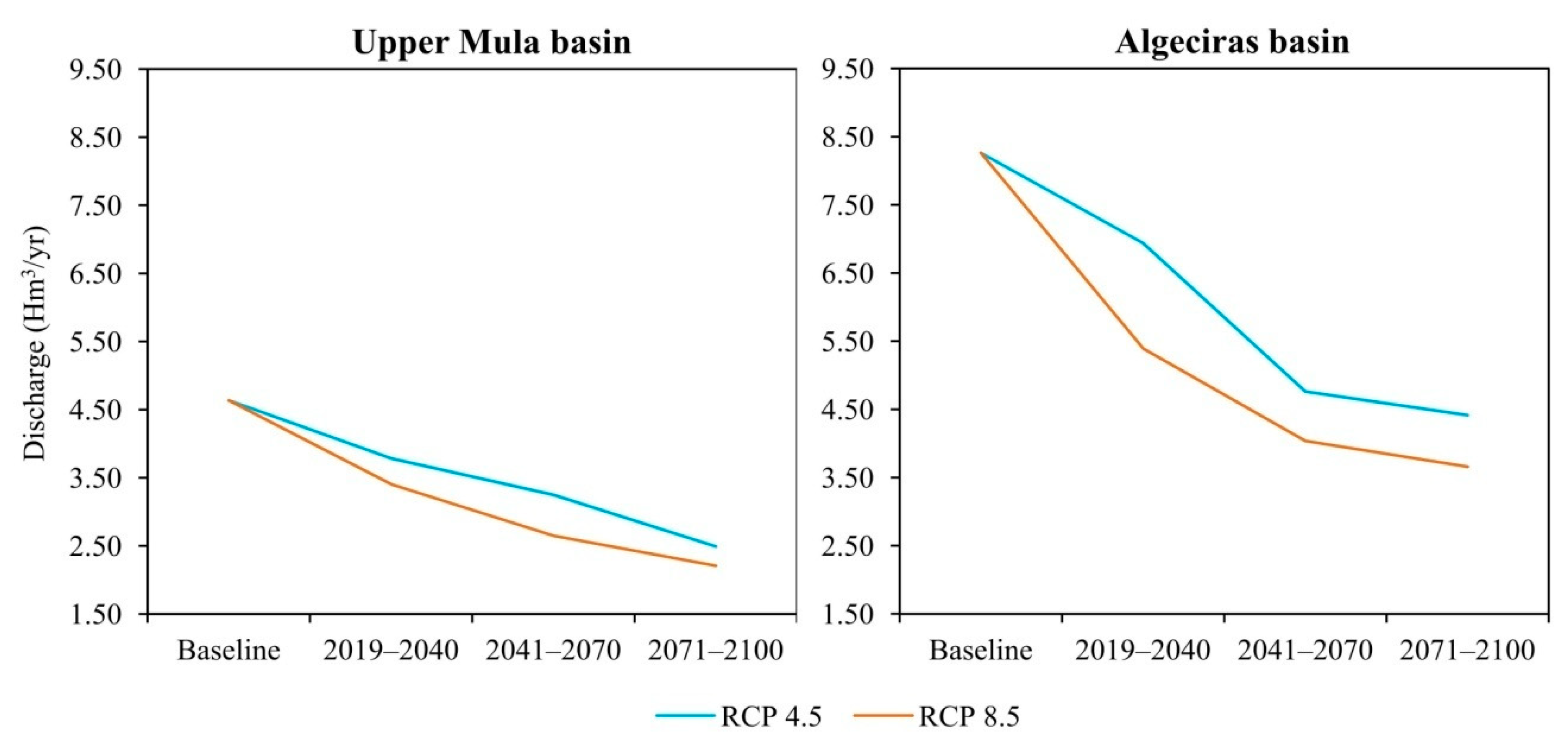
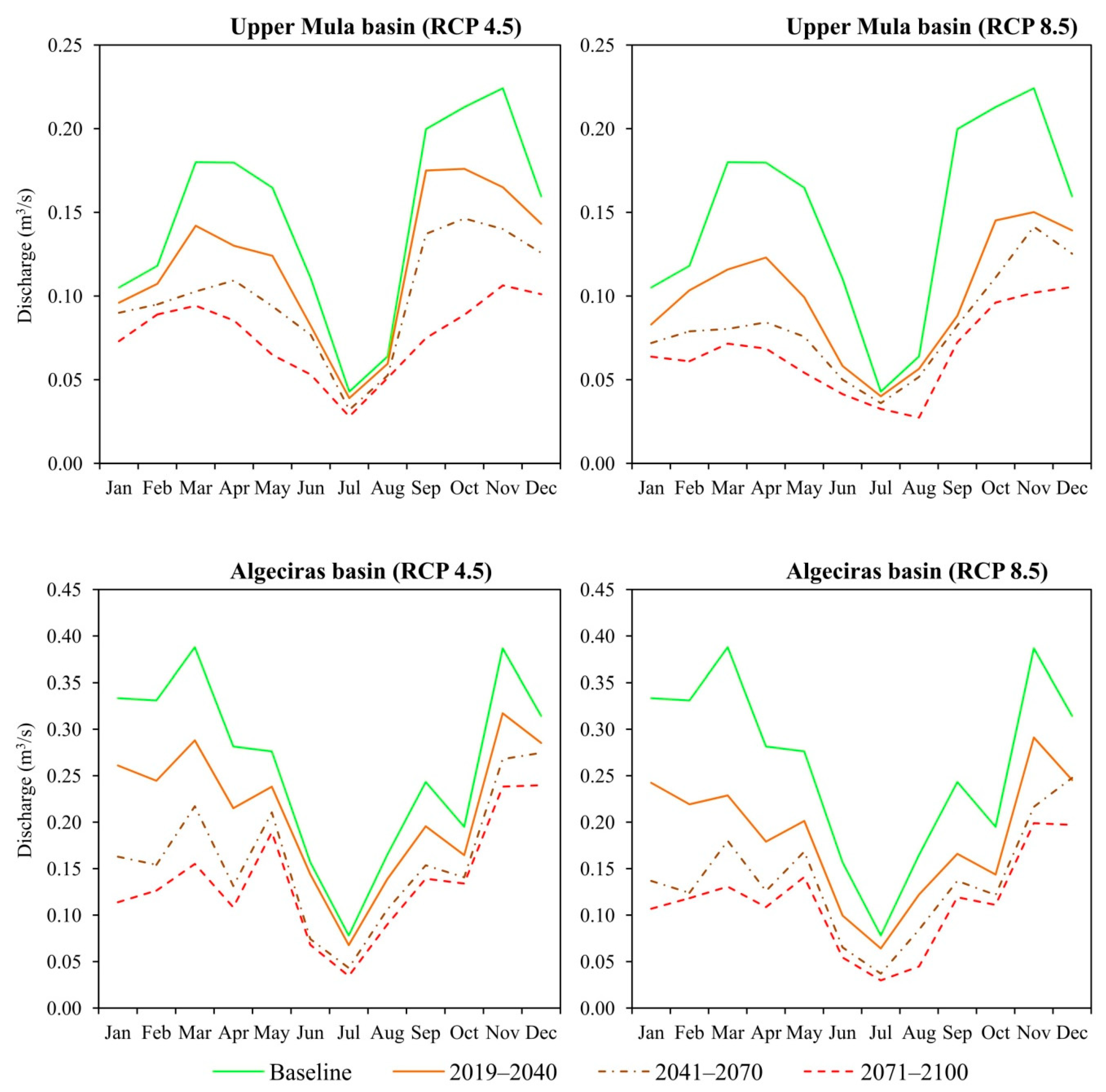
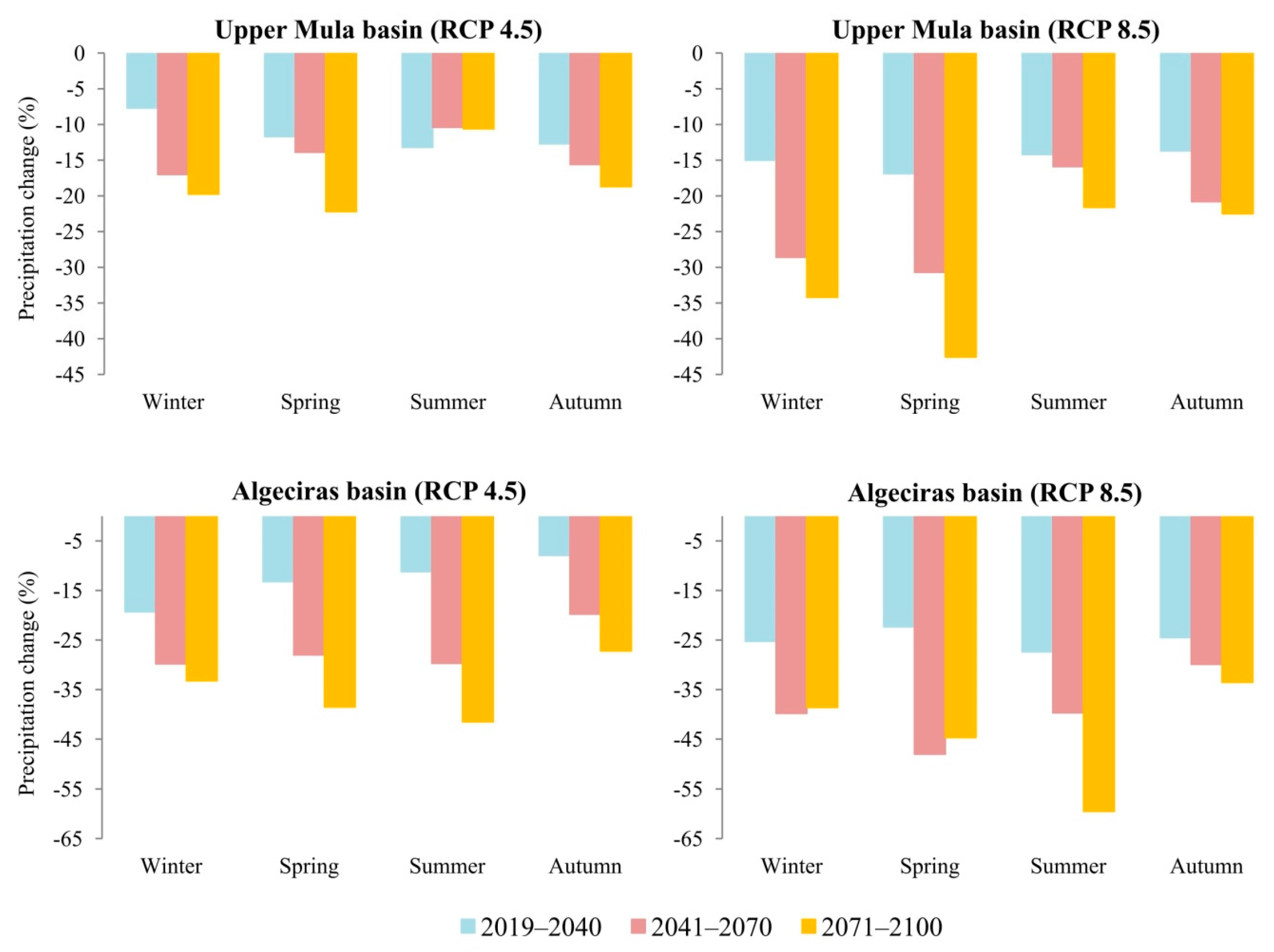
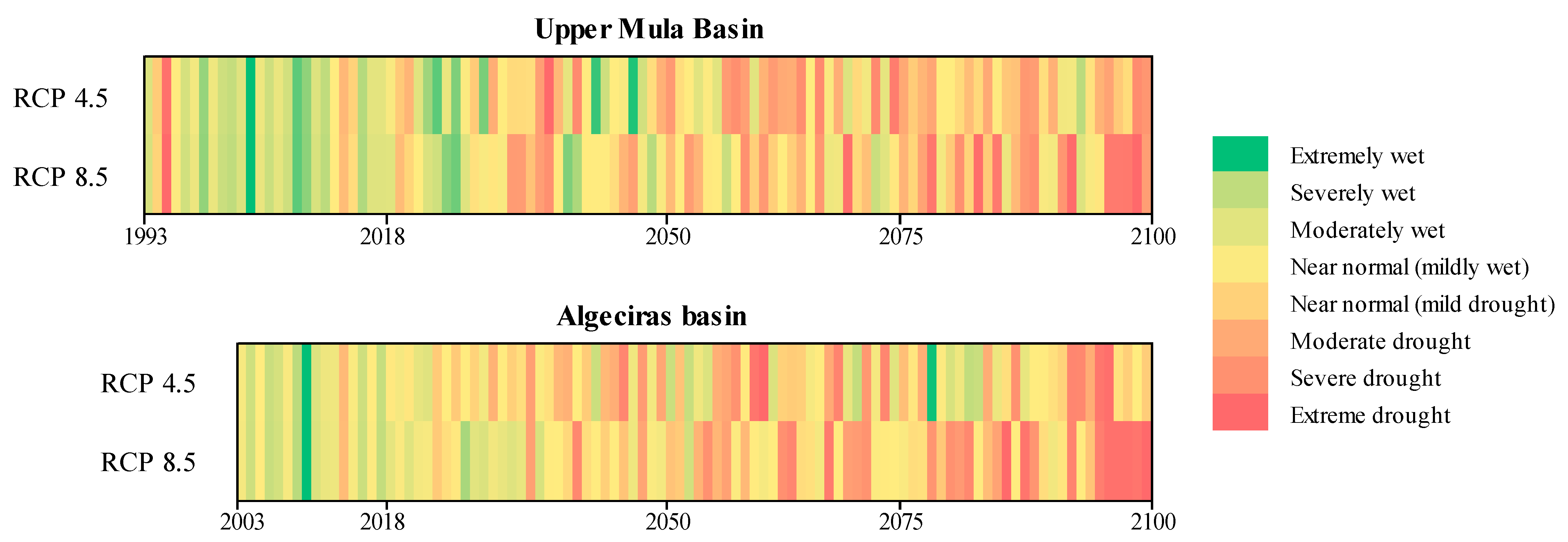
| Land Use | Upper Mula Basin (%) | Algeciras Basin (%) |
|---|---|---|
| Agricultural row crop | 25.23 | 12.03 |
| Bare soil | 0.11 | 24.28 |
| Forest evergreen | 39.03 | 27.78 |
| Orchard | 14.01 | 7.05 |
| Pasture | 0.39 | 3.44 |
| Shrub/Scrub | 20.03 | 24.04 |
| Urban | 1.03 | - |
| Water storage | 0.16 | 1.38 |
| Input Variables | Description | Spatial Resolution |
|---|---|---|
| DTM | LIDAR | 20 m × 20 m |
| Land Use | CORINE Land Cover (2018) | 1:100,000 |
| Soil data | Project LUCDEME | 1:100,000 |
| Meteorological data 1 | Daily data of precipitation (mm), minimum temperature (°C) and maximum temperature | Station point data |
| Climate projection | Daily data of precipitation (mm), minimum temperature (°C) and maximum temperature (°C) | EUR–11, ~12.5 km |
| Hydrological data 2 | Daily average flow (m3/s) and daily evapotranspiration (mm) | Station point data |
| GCM | RCM | Institution |
|---|---|---|
| CNRM-CM5_r1i1p1 | CCLM4-8-17_v1 | CLMcom |
| CNRM-CM5_r1i1p1 | ALADIN53_v1 | CNRM |
| CNRM-CM5_r1i1p1 | RCA4_v1 | SMHI |
| EC-EARTH_r12i1p1 | CCLM4-8-17_v1 | CLMcom |
| EC-EARTH_r12i1p1 | RCA4_v1 | SMHI |
| EC-EARTH_r1i1p1 | RACMO22E_v1 | KNMI |
| EC-EARTH_r3i1p1 | HIRHAM5_v1 | DMI |
| CM5A-MR_r1i1p1 | WRF331F_v1 | IPSL-INERIS |
| CM5A-MR_r1i1p1 | RCA4_v1 | SMHI |
| HadGEM2-ES_r1i1p1 | CCLM4-8-17_v1 | CLMcom |
| HadGEM2-ES_r1i1p1 | RACMO22E_v1 | KNMI |
| HadGEM2-ES_r1i1p1 | RCA4_v1 | SMHI |
| MPI-ESM-LR_r1i1p1 | CCLM4-8-17_v1 | CLMcom |
| MPI-ESM-LR_r1i1p1 | RCA4_v1 | SMHI |
| MPI-ESM-LR_r1i1p1 | REMO2009 | MPI |
| NorESM1-M | HIRHAM5_v1 | DM |
| Parameter | Upper Mula Basin | Algeciras Basin | ||||||
|---|---|---|---|---|---|---|---|---|
| Rank | p-Value | t-Stat | Fitted Value | Rank | p-Value | t-Stat | Fitted Value | |
| ALPHA_BF.gw | 16 | 0.41 | −0.83 | 0.79 | 12 | 0.35 | −0.96 | 0.40 |
| ALPHA_BNK.rte | 5 | 0.03 | 2.31 | 0.78 | 21 | 0.65 | −0.46 | 0.83 |
| BIOMIX.mgt | 11 | 0.28 | −1.12 | 0.53 | 9 | 0.25 | −1.19 | 1.15 |
| CH_K2.rte | 3 | 0.00 | 4.79 | 1.62 | 2 | 0.05 | −2.04 | 1.02 |
| CH_N2.rte | 10 | 0.25 | 1.18 | −0.07 | 3 | 0.06 | −2.04 | −15.99 |
| CN2.mgt | 23 | 0.72 | 0.37 | 0.13 | 22 | 0.68 | −0.41 | −0.08 |
| DEEPST.gw | 15 | 0.41 | −0.85 | 38,612.08 | 20 | 0.63 | −0.49 | 21,324.44 |
| ESCO.hru | 1 | 0.00 | −13.92 | 0.65 | 16 | 0.43 | 0.81 | 0.82 |
| FFCB.bsn | 27 | 0.96 | 0.05 | 0.55 | 24 | 0.72 | −0.36 | 1.65 |
| GW_DELAY.gw | 26 | 0.91 | 0.11 | 514.51 | 14 | 0.39 | 0.88 | 388.13 |
| GW_SPYLD.gw | 14 | 0.36 | 0.94 | 0.14 | 13 | 0.36 | 0.93 | 0.34 |
| GWQMN.gw | 12 | 0.30 | −1.06 | 0.27 | 23 | 0.69 | 0.40 | 0.83 |
| HRU_SLP.hru | 2 | 0.00 | −15.81 | −0.01 | 7 | 0.14 | −1.54 | 0.07 |
| OV_N.hru | 17 | 0.44 | 0.79 | −0.03 | 4 | 0.06 | −1.98 | −0.04 |
| PLAPS.sub | 13 | 0.34 | −0.97 | 206.64 | 6 | 0.12 | 1.62 | 153.81 |
| RCHRG_DP.gw | 29 | 0.99 | 0.01 | −0.39 | 25 | 0.76 | −0.31 | 0.02 |
| REVAPMN.gw | 28 | 0.99 | −0.02 | −186.98 | 26 | 0.79 | −0.27 | −107.76 |
| SFTMP.bsn | 21 | 0.63 | 0.49 | 3.92 | 15 | 0.40 | −0.86 | −5.06 |
| SHALLST.gw | 20 | 0.54 | −0.62 | 29,527.58 | 10 | 0.29 | −1.09 | 48,833.96 |
| SLSUBBSN.hru | 22 | 0.67 | −0.43 | 0.06 | 5 | 0.09 | −1.76 | 0.03 |
| SMFMX.bsn | 19 | 0.51 | 0.67 | 10.33 | 11 | 0.29 | 1.08 | −2.17 |
| SMTMP.bsn | 8 | 0.20 | −1.34 | 31.03 | 17 | 0.44 | −0.79 | 14.74 |
| SOL_BD(..).sol | 4 | 0.00 | −3.71 | 0.19 | 28 | 0.93 | −0.09 | 0.11 |
| SOL_CRK.sol | 6 | 0.12 | −1.64 | 0.04 | 19 | 0.61 | −0.52 | 0.39 |
| SOL_K(..).sol | 25 | 0.91 | −0.12 | 0.39 | 1 | 0.00 | 3.86 | 2.01 |
| SURLAG.bsn | 24 | 0.84 | 0.20 | 16.23 | 27 | 0.86 | −0.18 | 2.33 |
| TIMP.bsn | 9 | 0.25 | −1.20 | 0.45 | 29 | 1.00 | 0.00 | 0.76 |
| TLAPS.sub | 18 | 0.48 | 0.72 | 2.99 | 8 | 0.23 | 1.25 | 11.70 |
| TRNSRCH.bsn | 7 | 0.17 | 1.42 | 7.19 | 18 | 0.47 | −0.74 | 8.27 |
| Statistic | Upper Mula Basin | Algeciras Basin | ||||||
|---|---|---|---|---|---|---|---|---|
| Calibration | Validation | Calibration | Validation | |||||
| Monthly | Yearly | Monthly | Yearly | Monthly | Yearly | Monthly | Yearly | |
| d | 0.94 | 0.94 | 0.97 | 0.95 | 0.97 | 0.99 | 0.98 | 0.97 |
| R2 | 0.79 | 0.82 | 0.88 | 0.85 | 0.88 | 0.99 | 0.94 | 0.96 |
| NS | 0.79 | 0.76 | 0.86 | 0.78 | 0.88 | 0.95 | 0.91 | 0.86 |
| RSR | 0.46 | 0.47 | 0.38 | 0.45 | 0.35 | 0.20 | 0.29 | 0.35 |
| PBIAS % | −4.50 | −4.70 | 7.40 | 7.40 | −2.50 | −3.00 | −7.10 | −7.50 |
| RMSE | 0.07 | 0.03 | 0.06 | 0.02 | 0.10 | 0.03 | 0.07 | 0.02 |
| Statistic | Upper Mula Basin | Algeciras Basin | ||||||
|---|---|---|---|---|---|---|---|---|
| Calibration | Validation | Calibration | Validation | |||||
| Monthly | Yearly | Monthly | Yearly | Monthly | Yearly | Monthly | Yearly | |
| d | 0.95 | 0.93 | 0.97 | 0.96 | 0.95 | 0.94 | 0.95 | 0.93 |
| R2 | 0.82 | 0.78 | 0.89 | 0.87 | 0.86 | 0.92 | 0.85 | 0.86 |
| NS | 0.79 | 0.76 | 0.87 | 0.79 | 0.78 | 0.83 | 0.82 | 0.85 |
| RSR | 0.46 | 0.47 | 0.36 | 0.44 | 0.41 | 0.39 | 0.42 | 0.47 |
| PBIAS % | −4.00 | −1.50 | 0.70 | 0.70 | −8.10 | −1.60 | −8.20 | −0.50 |
| RMSE | 28.12 | 95.09 | 16.93 | 47.27 | 31.29 | 112.35 | 29.66 | 66.70 |
| Methods | Upper Mula Basin | |||||||||
|---|---|---|---|---|---|---|---|---|---|---|
| La Cierva | Pinar Hermoso | Lorca Coy | ||||||||
| Prec | Tmax | Tmin | Prec | Prec | ||||||
| NS | PBIAS (%) | NS | PBIAS (%) | NS | PBIAS (%) | NS | PBIAS (%) | NS | PBIAS (%) | |
| RAW | 0.02 | 15.71 | 0.89 | −4.05 | 0.90 | 5.77 | −0.09 | 17.98 | 0.14 | 20.41 |
| LS | 0.89 | −3.59 | 0.98 | 1.85 | 0.92 | 7.89 | 0.70 | 6.65 | 0.82 | −2.88 |
| LOCI | 0.94 | 1.00 | - | - | - | - | 0.87 | −4.25 | 0.91 | 0.79 |
| PT | 0.85 | −2.88 | - | - | - | - | 0.79 | 5.79 | 0.74 | −7.85 |
| DM | 0.61 | 5.86 | 0.96 | 2.69 | 0.93 | 4.74 | 0.61 | 10.47 | 0.61 | 5.74 |
| EQM | 0.79 | −3.38 | 0.96 | 2.10 | 0.95 | −2.24 | 0.84 | 6.52 | 0.80 | 8.67 |
| VARI | - | - | 0.99 | 0.10 | 0.99 | 0.58 | - | - | - | - |
| Methods | Algeciras Basin | |||||||
|---|---|---|---|---|---|---|---|---|
| Los Quemados | Gebas | |||||||
| Prec | Tmax | Tmin | Prec | |||||
| NS | PBIAS (%) | NS | PBIAS (%) | NS | PBIAS (%) | NS | PBIAS (%) | |
| RAW | 0.24 | 10.83 | 1.00 | 0.29 | 0.99 | 0.43 | −0.02 | −19.94 |
| LS | 0.80 | −3.77 | 0.98 | −0.94 | 0.99 | −0.96 | 0.84 | 3.25 |
| LOCI | 0.91 | 2.64 | - | - | - | - | 0.93 | 2.21 |
| PT | 0.79 | −9.44 | - | - | - | - | 0.80 | −5.78 |
| DM | 0.71 | 9.75 | 0.97 | −0.16 | 0.96 | 1.28 | 0.69 | 9.96 |
| EQM | 0.70 | −8.69 | 0.98 | −0.78 | 0.99 | 2.19 | 0.82 | 5.88 |
| VARI | - | - | 1.00 | 0.27 | 1.00 | 0.05 | - | - |
| Variable | Baseline (1993–2018) | Period (2019–2040) | Period (2041–2070) | Period (2071–2100) | |||
|---|---|---|---|---|---|---|---|
| RCP 4.5 | RCP 8.5 | RCP 4.5 | RCP 8.5 | RCP 4.5 | RCP 8.5 | ||
| Prec (mm) | 351.67 | 306.6 (−12.8%) | 301.5 (−14.3%) | 297.9 (−15.3%) | 276.2 (−21.8%) | 290.1 (−17.5%) | 253.5 (−27.9%) |
| T (°C) | 17.68 | 17.9 (1.45%) | 18 (1.8%) | 18.3 (3.4%) | 18.9 (6.7%) | 18.7 (5.8%) | 20.2 (13.9%) |
| Q (m3/s) | 0.147 | 0.120 (−18.4%) | 0.108 (−26.2%) | 0.103 (−29.70%) | 0.084 (−42.8%) | 0.079 (−46.3%) | 0.07 (−52.4%) |
| PET (mm) | 1777.57 | 1783.2 (0.32%) | 1793.5 (0.9%) | 1831.9 (3%) | 1880.2 (5.8%) | 1853.2 (4.3%) | 2027.1 (14.1%) |
| RET (mm) | 280.83 | 279.2 (−0.6%) | 298.1 (6.2%) | 281.1 (0.1%) | 256.8 (−8.6%) | 273.9 (−2.5%) | 233.4 (−16.9%) |
| Variable | Baseline (1993–2018) | Period (2019–2040) | Period (2041–2070) | Period (2071–2100) | |||
|---|---|---|---|---|---|---|---|
| RCP 4.5 | RCP 8.5 | RCP 4.5 | RCP 8.5 | RCP 4.5 | RCP 8.5 | ||
| Prec (mm) | 334.5 | 295.7 (−11.6%) | 268.2 (−19.9%) | 239.8 (−28.3%) | 200.2 (−40.1%) | 230.5 (−31.2%) | 187.7 (−43.9%) |
| T (°C) | 16.4 | 18.1 (10.1%) | 18 (10.9%) | 18.7 (14.5%) | 19.5 (18.8%) | 19.5 (19.2%) | 21.3 (29.5%) |
| Q (m3/s) | 0.262 | 0.22 (−16%) | 0.171 (−34.8%) | 0.151 (−42.4%) | 0.128 (−51.2%) | 0.14 (−46.6%) | 0.116 (−55.8%) |
| PET (mm) | 1690.57 | 1857 (9.8%) | 1910.2 (13%) | 1963 (16.1%) | 2189.7 (29.5%) | 2056.1 (21.6%) | 2359.2 (39.5%) |
| RET (mm) | 239.46 | 235.8 (0.6%) | 215 (−10.2%) | 227.8 (−4.9%) | 205.8 (−14.1%) | 210.4 (−12.2%) | 198.3 (−17.9%) |
Publisher’s Note: MDPI stays neutral with regard to jurisdictional claims in published maps and institutional affiliations. |
© 2021 by the authors. Licensee MDPI, Basel, Switzerland. This article is an open access article distributed under the terms and conditions of the Creative Commons Attribution (CC BY) license (https://creativecommons.org/licenses/by/4.0/).
Share and Cite
Martínez-Salvador, A.; Millares, A.; Eekhout, J.P.C.; Conesa-García, C. Assessment of Streamflow from EURO-CORDEX Regional Climate Simulations in Semi-Arid Catchments Using the SWAT Model. Sustainability 2021, 13, 7120. https://doi.org/10.3390/su13137120
Martínez-Salvador A, Millares A, Eekhout JPC, Conesa-García C. Assessment of Streamflow from EURO-CORDEX Regional Climate Simulations in Semi-Arid Catchments Using the SWAT Model. Sustainability. 2021; 13(13):7120. https://doi.org/10.3390/su13137120
Chicago/Turabian StyleMartínez-Salvador, Alberto, Agustín Millares, Joris P. C. Eekhout, and Carmelo Conesa-García. 2021. "Assessment of Streamflow from EURO-CORDEX Regional Climate Simulations in Semi-Arid Catchments Using the SWAT Model" Sustainability 13, no. 13: 7120. https://doi.org/10.3390/su13137120
APA StyleMartínez-Salvador, A., Millares, A., Eekhout, J. P. C., & Conesa-García, C. (2021). Assessment of Streamflow from EURO-CORDEX Regional Climate Simulations in Semi-Arid Catchments Using the SWAT Model. Sustainability, 13(13), 7120. https://doi.org/10.3390/su13137120








